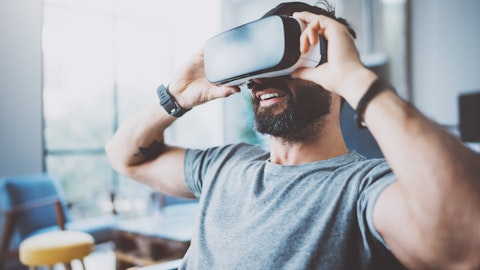Atif Malik: Hi, thank you for taking my questions. I have a question on the full-year guide. If I look at your high-end of the guide, it’s still below the high teens OLED material growth at some third parties, like DSCC are projecting. So I’m wondering if you can pull the curtain a bit on what goes into your guidance? Why is it below the industry growth for OLED materials and are you just being conservative?
Brian Millard: Yeah, so, I wouldn’t say there is necessarily conservatism baked into our forecast, we think it’s a balanced guidance range and balanced forecast that we have. So it’s really based on the feedback that we get from our customers in terms of what their expected demand is going to be, as well as we look at the similar industry reports as you in terms of where the industry is going and also layer that intelligence on top of what we’re hearing from our customers and our teams in the field. So when we kind of roll all that up this year, we got to the range that we published in terms of our guidance for ’24. We certainly hope you’re right and it’s higher, but at this point, this is what we’re seeing as we roll up our forecast from our field teams.
Atif Malik: Great. And as my follow-up, we hear noise around some of your Chinese customers working with domestic private companies like Summer Sprout Technology in Shangxi, and I understand you guys have long term agreements with your Chinese customers, but can you just talk about the competitive dynamics in China and is there a risk of these domestic suppliers are getting qualified?
Steven Abramson: Well, we are seeing some localizations coming from the Chinese government. They’re trying to get some localization in the OLED industry. But what we’re seeing is that customers want our full suite of current and next-generation OLED materials and technology solutions, which is one of the reasons why all these major panel makers are working with us and has signed long-term agreements, because we work closely with our customers to understand all the specification requirements that they have today and into the future.
Atif Malik: Thanks, Steve.
Operator: Our next question is from Nam Kim with Arete Research. Please proceed.
Nam-Hyung Kim: Hi, thank you for taking my question. A couple of questions on blue. Can you also explain about the timing of your commercial production this year? And also do you expect customer qualification to kick-off this year or next year? And then I also wonder, do you expect your blue material to be adapted in IT first or across the segment at the same timing?
Brian Millard: Thanks, Nam. So, in terms of the commercialization timeline, I think our team is really focused right now on making sure that we continue to increase the performance of our material and get closer to those commercial specifications, where, again, as I said earlier, very pleased with the progress that we’ve made to date. Continuing to feel like we’re moving in the right direction. In terms of what our customers may introduce that into their product portfolios, that’s really up for them to determine, but we continue to feel like we’re moving much closer toward the mark that our material will be considered commercial performance. So I think that’s kind of as much as I can say at this point based on where things sit.
Nam-Hyung Kim: Okay. And then, I see some momentum picking up in China, because Chinese OLED suppliers increasing their production for local smartphone vendor, can you share your view on Chinese business? How much growth do you expect from Chinese customers this year versus last year? Thank you.
Brian Millard: Yes, so we’re certainly projecting growth. We — as Steve just mentioned, we have longstanding partnerships with our customers in China. We provide best-in-class materials to our customers, also with the Next-Gen platforms, as well as access to our current materials. We think that there is a strong partnership between us and our Chinese customers that we expect to be longstanding.
Nam-Hyung Kim: Okay. Thank you.
Brian Millard: Thanks.
Operator: [Operator Instructions] Our next question is from Jim Ricchiuti with Needham and Company. Please proceed.
Chris Grenga: Hi, this is Chris Grenga on for Jim. Did you — I’m sorry, I cut out earlier, but — did you mention any progress updates with respect to discussions you’re having around OVJP with potential partners?
Brian Millard: We did not, but as we’ve talked about previously, we’re certainly open to partnerships with OVJP, that could help us advance the project forward. We continue to believe that OVJP is the solution for large area television, large area displays on TV sized, and so we’re open to various discussions and have had it, and continue to have various discussions with potential partners.
Chris Grenga: Got it. And SG&A stepped down sequentially year-over-year, could you provide any color on that?
Brian Millard: Sure. The biggest factor there is, for the first half of 2022, before we operationalized our Shannon site, we were recording the cost of that site to SG&A for the first half of 2022 and that was around $5 million. And then, so from mid-’22 onward, those costs are classified in cost-of-sales. The other factor is, we had some reduced stock-compensation expenses year-over-year that are flowing through SG&A, those are the two largest factors that are contributing to the decrease.
Chris Grenga: Got it. Thank you. And maybe just one more sort of bigger picture, with the recent launch of Apple’s device, the Apple Vision, and the proliferation of some use-case videos, showing — screens plastered and augmented reality across all the surfaces now sold, it would strike me as potentially — a potential to display some, maybe TV, and even leapfrog some of the IT use cases for OLED, I’m curious — I mean it’s early days, of course, but I’m just curious if you had any exposure to these devices or similar devices. And if there is any concern that it would — any concern whatsoever that it would pose risks to some of the growth rates that were cited earlier.


